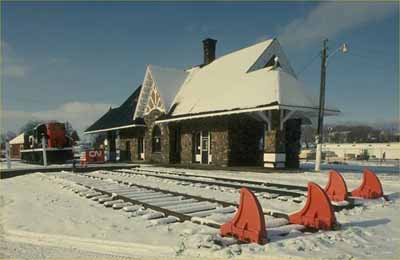Kensington Railway Station (Prince Edward Island) National Historic Site of Canada
Kensington, Prince Edward Island

General view
(© Parks Canada Agency/ Agence Parcs Canada, 1987.)
Address :
13 Commercial Street, Kensington, Prince Edward Island
Recognition Statute:
Historic Sites and Monuments Act (R.S.C., 1985, c. H-4)
Designation Date:
1976-06-15
Dates:
-
1904 to 1904
(Construction)
Event, Person, Organization:
-
Prince Edward Island Railway
(Organization)
-
Charles Chappell
(Architect)
-
M.F. Schurman
(Builder)
Other Name(s):
-
Kensington Railway Station (Prince Edward Island)
(Designation Name)
Research Report Number:
1976-E, 1974-C, 1992-9, 94-37
Plaque(s)
Existing plaque: 13 Commercial Street, Kensington, Prince Edward Island
In 1871 the Colony of Prince Edward Island embarked upon the construction of a circuitous 147-mile railway covering the 120-mile distance between Georgetown and Alberton. The high cost of building the line added substantially to the public debt and helped to persuade the colony to enter Confederation in 1873. The town of Kensington was among the numerous communities accommodated by the Prince Edward Island Railway. This distinctive stone station was designed by an Island architect, Charles Chappell, and built in 1904 to replace an earlier frame structure.
Description of Historic Place
Kensington Railway Station National Historic Site of Canada is a picturesque fieldstone building with a high gable roof and sheltered platforms at each of its gable ends. For almost a century, it was the passenger station at the town of Kensington for the Prince Edward Island Railway. In 1999 the station was conserved as the centre-piece of the former railyards, now rehabilitated as a tourist venue. The designation refers to the railway station building on its footprint.
Heritage Value
Kensington Railway Station was designated a national historic site of Canada in 1976 because: it commemorates the development of the Maritime Railways; and it is a rare surviving example of a Prince Edward Island Railway station.
Kensington Railway Station National Historic Site of Canada was designed by Prince Edward Island architect Charles Chappell and built in 1904-1905 by local construction company M.F. Schurman for the Prince Edward Island Railway. The railway had been in operation since 1871 with a 147 mile line that extended from Georgetown to Alberton. This station replaced an earlier frame station in Kensington and was built to accommodate passenger traffic, freight facilities being housed in a separate building to the north. Passenger traffic was suspended in Prince Edward Island in 1969 and the Town of Kensington purchased the station in 1985 with the intent of restoring it for public use.
Sources: Historic Sites and Monuments Board of Canada, Minutes, June 1976, June 1978, November 1994.
Character-Defining Elements
Key features contributing to the heritage value of this site include: the station's site beside the track; the station's low, rectangular massing under a steeply pitched gable roof; its hipped roofed canopies on the north and south ends of the building; its centrally placed track-side telegrapher's bay with large arched window under an elaborately detailed gable; its picturesque aesthetic, enhanced by prominent door and window surrounds, segmentally arched door openings flanked by sidelights on the bay and rear facades, the use of gables to define door and bay features, decorative half-timbered bay and end gables with verge boards and exposed brackets, platform finials and stone pillars; its New Brunswick fieldstone construction; legibility of its original interior layout, functional and spatial configuration, particularly special features related to railway use such as separate men's and ladies' waiting rooms, baggage room; the integrity of furnishings and fittings from the railway era, particularly the central office and ticket counter, wood-paneled office and waiting rooms and the legibility of the heirarchy of decoration and finish of public and utilitarian spaces such as the contrast between waiting rooms and the baggage area; viewscapes up and down the track.